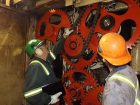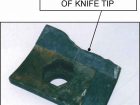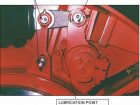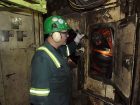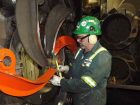
Features
Maintenance
Sawmilling
Debarker maintenance
Aug. 16, 2016 - When it comes to keeping a sawmill’s debarkers running in tip-top shape and preventing unnecessary downtime, the key is proactive maintenance.
August 11, 2016 By Andrew Snook
 Russell Stewart When it comes to keeping a sawmill’s debarkers running
Russell Stewart When it comes to keeping a sawmill’s debarkers runningRussell Stewart, Western Canadian service technician and parts specialist for Nicholson Manufacturing, offered Canadian Forest Industries some useful tips to help mill maintenance staff put together a proactive maintenance plan.
When planning out a proactive maintenance schedule, routine and extended maintenance should be included.
“Routine being your basic day-to-day maintenance on the machine, like lubrication,” Stewart explains. “Other things we look for in routine maintenance are general wear items, or consumables on the machines, which include evaluation of the condition of the knife tips and knife arms.”
A proactive maintenance schedule can be broken down into several categories:
Safety first
Stewart says the first thing to consider before any maintenance is performed is ensuring the environment is safe to work in.
“As far as debarker maintenance goes, the first thing to consider is safety,” he says. “Because these machines have a lot of heavy parts – moving parts – complete de-energization of the machine is always first and foremost. Safety is our No. 1 priority when we’re performing inspections and maintenance.”
Lubrication
Adhering to the lubrication schedule suggested by the equipment manufacturer is vital for keeping debarkers running.
“Proper lubrication required for your feedworks and your ring components is important,” Stewart says. “When lubricating the machine it’s important to inspect all of your lubrication lines and any fittings that may have come loose; and that all of your feed gears and lubrication points on your machines are getting proper lubrication.
“We have lubrication charts in our manuals that break down when components need to be lubricated and how much lubrication is needed per day on the machine. Referring to your operations manual for those specifications is key.”
Another area to remember to check during routine maintenance is to inspect your lube pumps, and making sure all of your components that run your lubrication system are working well.
Visual checks
Looking at the knife arms and knife tips to see what condition they’re in should be part of a millwright’s proactive routine maintenance tasks.
“You should be following your maintenance manuals looking at what condition or time interval they need to be changed,” Stewart says. “For instance, knife tips and knife arms require a once-per-shift visual check every eight hours. When you look at our knife tips, and where they’re attached, they should be checked every eight hours and torqued to the specs in the machine manual. Knife arms should be checked every 40 hours of operation.”
The main component of the machines, the debarker ring, should have a complete visual check every 40 hours of operation. Another thing maintenance staff should be looking for while doing visual inspections is bearing wear.
“It’s very crucial to how these machines operate since they are running on big bearings,” Stewart says. “Your feedworks, drive gears, belts – anything that is part of your feed drive system – all should be checked on a regular basis.”
Listen
Stewart also recommends that millwrights and other maintenance staff listen to the debarkers during operation.
“When the guys are looking at the machines they’re shut down, but prior to getting in you should be listening to your machine to know what it should sound like,” he says. “Listen for vibrations, and other noises that aren’t usually there.”
Uniformity
A uniform tool circle is also very important for keeping debarkers running smoothly.
“A uniform tool circle puts equal pressure on all the knife arms that are on the debarking ring,” Stewart explains. “If your tool circle is out, you’ve basically got one arm putting more pressure on the log, doing more of the work, so you want to keep a good uniform circle at the specification that is in the maintenance manual. This differs according to the size of the machine.”
As the machine gets bigger, the tool circle will increase in size.
“For instance, a 22-inch machine will have a uniform tool circle of about three inches,” Stewart says.
Feed system
The condition of the feedrolls and inserts is another important aspect to monitor.
“What we call your inserts or spikes, that hold the log in position, should have a minimum height of 0.38 of an inch,” Stewart says. “If they’re getting worn down, we’re looking at getting those changed out right away.”
Nicholson recommends different roll configurations or inserts for machines, depending on the wood being processed.
“Feed gears, or main drive gears, should be looked at daily and maintained every 40 hours,” Stewart adds. “We check the backlash on the gears to make sure it’s not excessive and that the gears are rotating smoothly. You’re also looking for any anomalies or any wear patterns due to lack of lubrication or improper installation after repairs are done.”
Long-term maintenance
When it comes to long-term maintenance, this should include full servicing of the machines.
”It’s highly recommended that a company have a Nicholson service tech come in and do a field service inspection at least twice a year,” Stewart says. “They’ll go over the full machine from front to back and do an inspection on everything.”
Clean air
Because a lot of debarkers run on air, making sure a good supply of clean, dry air is coming into the machine is vital.
“Inspection of air cylinders, air bags that operate the knife arms and other components is very important for how well this machine will run,” Stewart says.
Hydraulics
Some of the newer machines installed in Canada have hydraulic feedroll control, which means different maintenance requirements.
Routine inspections should include checking hydraulic valving, ensuring the proper hydraulic oil is in the system, and making sure all of the hydraulic components are running in their best condition.
Keep it clean
Build-up of debris is another thing to be looking for during routine maintenance.
“Make sure the bark cleaner is always in good condition,” Stewart says. “Evacuate the bark as it builds up around the ring. As far as cleaning goes in Canada, especially in B.C., dust is a really big issue. That’s part of keeping your machine clean as a maintenance guy.”
Last but not least, Stewart stresses the importance of using replacement parts that are supplied by the original equipment manufacturer (OEM).
Print this page
